 According to the Guinness Book of World Records, the Commodore 64 still stands today as the best selling computer of all time. Its revolutionary graphic and sound chips combined with an insanely affordable price propelled the Commodore line of computers into the history books. Its 15,000+ game library didn’t hurt, either.
According to the Guinness Book of World Records, the Commodore 64 still stands today as the best selling computer of all time. Its revolutionary graphic and sound chips combined with an insanely affordable price propelled the Commodore line of computers into the history books. Its 15,000+ game library didn’t hurt, either.
In the early 1980’s, three major companies competed for the exploding home computer market. While IBM marketed their computers to businessmen and Apple infiltrated the school system, the Commodore 64 shined in one very specific area: games. With a video chip (VIC) that produced an unmatched 320 x 240 resolution and 16 simultaneous colors and a sound chip (SID) capable of 3 independent voices, Commodore games quickly surpassed the games available for other computers. In fact, it was not uncommon for Apple and IBM games to feature Commodore screenshots in their marketing materials. Many people never got past the image of the Commodore 64 as a “gaming console with a disk drive.”
The Commodore 64 launched in 1982 for $595 and had dropped to $200 by 1983 (compare to the Apple IIe, which sold for $1395 in 1983). The basic system came with 64k of RAM and had BASIC and DOS built in. The Commodore 64 could be hooked to a monitor or directly to your television through an RF adapter. Games were available in three formats: cartridge, cassette tape (more prevalent in Europe), or disk drive (more prevalent in the US). One of the handiest features of the Commodore 64 was its compatibility with Atari 2600 joysticks.
The Commodore 64 wasn’t without problems. For one, Commodore systems tended to run hot. Really hot. I personally owned two fans for my system, one for the computer’s power supply and the other for my disk drive. Another big complaint early in the system’s life was the slow disk drive access times, a problem that was virtually eliminated with Epyx’s Fast Load Cartridge (and several clones that followed).
The Commodore 64 appeared in several variations over the years. In 1985, Commodore released the Commodore 128 (which could be started in either C64 or C128 mode). The Commodore 64 also appeared in a 25-pound portable version (the SX-64), and in a sleeker case which resembled the C128 and Amiga (called the Commodore 64C). Software and peripherals were completely interchangeable between these models. Later computers in the Commodore line, including the Commodore Plus 4 and the Commodore 16, would not run most Commodore 64 programs – and their sales reflected this.
In 1985, Commodore released the Amiga 1000, a spiritual successor to the Commodore 64. The Amiga contained even better graphics and sound capabilities than the Commodore 64 did, but many loyal Commodore 64 owners refused to give up their little beige boxes. 12 years after the launch of the 64, Commodore closed its doors and was eventually sold off in 1995.
While my dad had both an Apple II and an IBM XT in the living room, I had a Commodore 64 in my bedroom. I spent many nights not only playing the latest games, but talking to friends via BBSs and of course, trading games (which wasn’t nearly the big deal it is today). From Archon to Zork, I set out to play every one of those 15,000 titles. Throughout the 10 years I had my Commodore hooked up, I got through about 4,000 of them.
In an age of gigabits and gigahertz, it’s amazing that a machine that runs at 1 megahertz and holds 180k per floppy still has fans. Not only is new Commodore 64 software constantly appearing, but new pieces of hardware are appearing as well. Did you know you could connect a Commodore 1541 disk drive to your PC and transfer games back and forth? There are also devices available that allow you to connect IDE hard drives to your C64. There’s even a broadband adapter and new operating system that will allow your Commodore 64 to run TCP/IP and access the Internet! Tulip Computers, the current owners of the Commodore brand name, have even released a “30-in-1” Joystick, with 30 classic Commodore 64 games in one easy to play package. The popularity and legacy of the Commodore 64 is undeniable.
The majority of this section of Phosphor Dot Fossils focuses on what made the Commodore 64 so great and what kept it alive all those years – the games. Whether you prefer emulation or the real thing, you owe it to yourself to check out the games on this list. For nearly a decade, the Commodore 64 was the gaming system to which all other computer games were compared, many of which still hold up today.
[jwcatpostlist orderby=title order=asc includecats=122]
 The Game: On a somewhat fantastic voyage into the human body, you’re in a tiny ship (presumably with Martin Short along for the ride) on a mission to blast diseased cells out of the bloodstream. Naturally, it’s not as easy a task as it sounds; the cells split into smaller cells when you zap them, and you have to clear even the tiniest remnants off the screen before advancing to the next treatment. (Arcadia, 1982)
The Game: On a somewhat fantastic voyage into the human body, you’re in a tiny ship (presumably with Martin Short along for the ride) on a mission to blast diseased cells out of the bloodstream. Naturally, it’s not as easy a task as it sounds; the cells split into smaller cells when you zap them, and you have to clear even the tiniest remnants off the screen before advancing to the next treatment. (Arcadia, 1982)
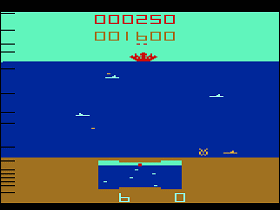 The Game: It’s a cold warrior’s nightmare! Enemy submarines glide silently through the seas below, but the only ordnance available isn’t of the guided variety. From a destroyer on the surface of the ocean, players have to carefully drop depth charges; taking out enemy subs will depend on timing and sheer luck. Failing to take out enemy subs – and wasting depth charges – will result in a deadly sinking feeling… (Sega, 1982)
The Game: It’s a cold warrior’s nightmare! Enemy submarines glide silently through the seas below, but the only ordnance available isn’t of the guided variety. From a destroyer on the surface of the ocean, players have to carefully drop depth charges; taking out enemy subs will depend on timing and sheer luck. Failing to take out enemy subs – and wasting depth charges – will result in a deadly sinking feeling… (Sega, 1982)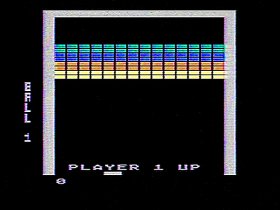 The Game: You’ve got a mobile paddle and – well, frankly, balls. But you don’t have a lot of balls at your disposal (am I the only one becoming a little bit uncomfortable discussing this?), so you have to make the best use of them that you can to knock down the rows of colorful bricks overhead. In some games, there may be other, free-floating balls trapped in “cavities” in the bricks, and setting them loose will mean you’ll have several balls – and not all of them necessarily yours, disturbingly enough – to handle. Missing one of your balls – and we all know how painful that can be – forces you to call another ball into play. Losing all of your balls, as you’ve probably guessed by now, ends the game. So, in essence, Super Breakout is a metaphor for life from the masculine perspective. (Atari, 1982)
The Game: You’ve got a mobile paddle and – well, frankly, balls. But you don’t have a lot of balls at your disposal (am I the only one becoming a little bit uncomfortable discussing this?), so you have to make the best use of them that you can to knock down the rows of colorful bricks overhead. In some games, there may be other, free-floating balls trapped in “cavities” in the bricks, and setting them loose will mean you’ll have several balls – and not all of them necessarily yours, disturbingly enough – to handle. Missing one of your balls – and we all know how painful that can be – forces you to call another ball into play. Losing all of your balls, as you’ve probably guessed by now, ends the game. So, in essence, Super Breakout is a metaphor for life from the masculine perspective. (Atari, 1982) The Game: A lone space pilot is faced with the impossible task of fending off an entire alien invasion force single-handedly. Colliding with either the aliens or their decidedly unfriendly fire costs the player a ship. Clearing the screen of aliens only reveals a further wave of extraterrestrial killing machines. (Tigervision, 1982)
The Game: A lone space pilot is faced with the impossible task of fending off an entire alien invasion force single-handedly. Colliding with either the aliens or their decidedly unfriendly fire costs the player a ship. Clearing the screen of aliens only reveals a further wave of extraterrestrial killing machines. (Tigervision, 1982)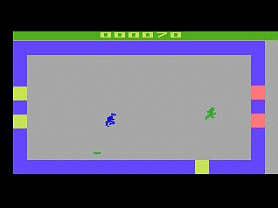 The Game: You are Tron, a lone video game warrior pitted against three other enemies with much greater armament. You can take a number of hits before you’re “de-rezzed” out of existence, but those hits can pile up pretty quickly. By throwing your disc at certain portions of the arena wall and changing them to the same color as your on-screen character, you can make tunnels for yourself – not unlike the side tunnels in Pac-Man – handy for escape or ambush. (M Network [Mattel], 1982)
The Game: You are Tron, a lone video game warrior pitted against three other enemies with much greater armament. You can take a number of hits before you’re “de-rezzed” out of existence, but those hits can pile up pretty quickly. By throwing your disc at certain portions of the arena wall and changing them to the same color as your on-screen character, you can make tunnels for yourself – not unlike the side tunnels in Pac-Man – handy for escape or ambush. (M Network [Mattel], 1982)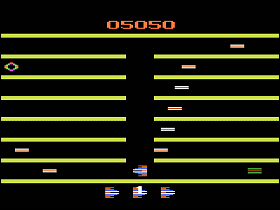 The Game: Players pilot a ship trapped in a maze of vertically stacked level, teeming with aliens who are all deadly to the touch. The good news is that the ship has an inexhaustible supply of ammo. The not-so-good news is that the bad guys have an inexhaustible supply of bad guys. Players have to keep the ship from colliding with the enemy, while shooting at the enemy and watching out for split-second opportunities to grab any bonus items that may make a fleeting appearance. Just one word of caution: the prizes turn into smart bombs if you wait too long to go pick them up. (20th Century Fox, 1982)
The Game: Players pilot a ship trapped in a maze of vertically stacked level, teeming with aliens who are all deadly to the touch. The good news is that the ship has an inexhaustible supply of ammo. The not-so-good news is that the bad guys have an inexhaustible supply of bad guys. Players have to keep the ship from colliding with the enemy, while shooting at the enemy and watching out for split-second opportunities to grab any bonus items that may make a fleeting appearance. Just one word of caution: the prizes turn into smart bombs if you wait too long to go pick them up. (20th Century Fox, 1982) The Game: You type! It talks! And occasionally you have to throw the damnedest misspellings at it to get it to say the simplest words. And despite the back of the box claiming that it “plays fun games,” it’s much more likely that it’ll just make some fun (and weird) sounds. (Magnavox, 1982)
The Game: You type! It talks! And occasionally you have to throw the damnedest misspellings at it to get it to say the simplest words. And despite the back of the box claiming that it “plays fun games,” it’s much more likely that it’ll just make some fun (and weird) sounds. (Magnavox, 1982)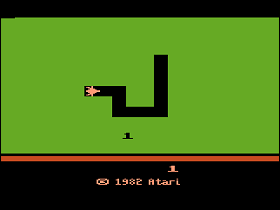 The Game: Your Vanguard space fighter has infiltrated a heavily-defended alien base. The enemy outnumbers you by six or seven to one at any given time (thank goodness for animated sprite limitations, or you’d be in real trouble!). You can fire above, below, ahead and behind your ship, which is an art you’ll need to master since enemy ships attack from all of these directions. You can’t run into any of the walls and expect to survive, but you can gain brief invincibility by flying through an Energy block, which supercharges your hull enough to ram your enemies (something which, at any other time, would mean certain death for you as well). At the end of your treacherous journey lies the alien in charge of the entire complex – but if you lose a life at that stage, you don’t get to come back for another shot! (Atari, 1982)
The Game: Your Vanguard space fighter has infiltrated a heavily-defended alien base. The enemy outnumbers you by six or seven to one at any given time (thank goodness for animated sprite limitations, or you’d be in real trouble!). You can fire above, below, ahead and behind your ship, which is an art you’ll need to master since enemy ships attack from all of these directions. You can’t run into any of the walls and expect to survive, but you can gain brief invincibility by flying through an Energy block, which supercharges your hull enough to ram your enemies (something which, at any other time, would mean certain death for you as well). At the end of your treacherous journey lies the alien in charge of the entire complex – but if you lose a life at that stage, you don’t get to come back for another shot! (Atari, 1982)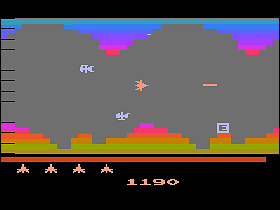

 The Game: As intrepid (and perpetually happy) adventurer Winky, armed only with a bow and arrow, you’re on a treasure hunt of the deadliest kind. HallMonsters try to stop you at every turn, and their minions guard the individual treasures that lie in the rooms of the maze. You can kill the smaller creatures (though their decomposing remains are still deadly to touch), but the HallMonsters are impervious to your arrows – and you’re lunch. (Coleco, 1982)
The Game: As intrepid (and perpetually happy) adventurer Winky, armed only with a bow and arrow, you’re on a treasure hunt of the deadliest kind. HallMonsters try to stop you at every turn, and their minions guard the individual treasures that lie in the rooms of the maze. You can kill the smaller creatures (though their decomposing remains are still deadly to touch), but the HallMonsters are impervious to your arrows – and you’re lunch. (Coleco, 1982)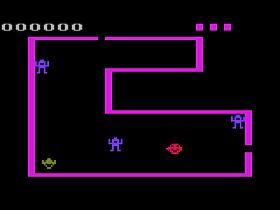 The Game: Trapped in a maze full of HallMonsters, you are adventurer Winky, on a mission to snatch incredible treasures from hazardous underground rooms inhabited by lesser beasts such as re-animated skeletons, goblins, serpents, and so on. Sometimes even the walls move, threatening to squish Winky or trap him, helpless to run from the HallMonsters. The deeper into the dungeons you go, the more treacherous the danger – and the greater the rewards. Just remember two things – the decomposing corpses of the smaller enemies are just as deadly as the live creatures. And there is no defense – and almost never any means of escape – from the HallMonsters. (Coleco, 1982)
The Game: Trapped in a maze full of HallMonsters, you are adventurer Winky, on a mission to snatch incredible treasures from hazardous underground rooms inhabited by lesser beasts such as re-animated skeletons, goblins, serpents, and so on. Sometimes even the walls move, threatening to squish Winky or trap him, helpless to run from the HallMonsters. The deeper into the dungeons you go, the more treacherous the danger – and the greater the rewards. Just remember two things – the decomposing corpses of the smaller enemies are just as deadly as the live creatures. And there is no defense – and almost never any means of escape – from the HallMonsters. (Coleco, 1982) The Game: You’re the pilot of a lone fighter ship, screaming down the trench-like, heavily armed confines of a spaceborne fortress, on a mission to find and destroy the Zaxxon robot – the most heavily guarded of all – at the heart of the structure. (Coleco, 1982)
The Game: You’re the pilot of a lone fighter ship, screaming down the trench-like, heavily armed confines of a spaceborne fortress, on a mission to find and destroy the Zaxxon robot – the most heavily guarded of all – at the heart of the structure. (Coleco, 1982) The Game: You’re the sole space fighter pilot penetrating a heavily-armed, mobile alien fortress. If you can survive wave after wave of fighters and ground defenses, you’ll have the opportunity to destroy the Zaxxon robot at the heart of the complex. (Coleco, 1982)
The Game: You’re the sole space fighter pilot penetrating a heavily-armed, mobile alien fortress. If you can survive wave after wave of fighters and ground defenses, you’ll have the opportunity to destroy the Zaxxon robot at the heart of the complex. (Coleco, 1982) The Game: The constant struggle between cat and dog requires a great deal of concentration. Two players can play, or one player can control the dog while the CPU makes moves as the “Microcat.” Each animal drops a piece into the playing field, trying to line up four pieces horizontally, vertically or diagonally, or trying to keep the other animal from lining up his four pieces. Whoever lines up four pieces first wins the game. (Phillips, 1982)
The Game: The constant struggle between cat and dog requires a great deal of concentration. Two players can play, or one player can control the dog while the CPU makes moves as the “Microcat.” Each animal drops a piece into the playing field, trying to line up four pieces horizontally, vertically or diagonally, or trying to keep the other animal from lining up his four pieces. Whoever lines up four pieces first wins the game. (Phillips, 1982)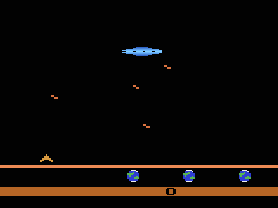 The Game: Players control a single laser cannon responsible for defending several planets who don’t seem to be able to look out for themselves. The cannon squares off against an alien mothership which deploys its own fleet of attack ships to destroy those planets. Good news: the planets are protected by a force field spanning the bottom of the screen. Bad news? The aliens can shoot through it, exposing the row of fragile planets as they scroll across the screen like shooting gallery targets. Worse news? You can’t defend all of them forever. (Games By Apollo, 1982)
The Game: Players control a single laser cannon responsible for defending several planets who don’t seem to be able to look out for themselves. The cannon squares off against an alien mothership which deploys its own fleet of attack ships to destroy those planets. Good news: the planets are protected by a force field spanning the bottom of the screen. Bad news? The aliens can shoot through it, exposing the row of fragile planets as they scroll across the screen like shooting gallery targets. Worse news? You can’t defend all of them forever. (Games By Apollo, 1982)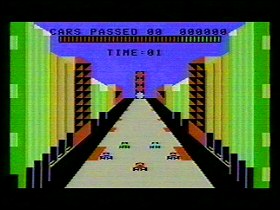 The Game: It’s pretty straightforward…you’re zipping along in your Formula One race car, trying to avoid other drivers and obstacles along the way while hauling a sufficient quantity of butt to win the race. (Coleco [under license from Sega], 1982)
The Game: It’s pretty straightforward…you’re zipping along in your Formula One race car, trying to avoid other drivers and obstacles along the way while hauling a sufficient quantity of butt to win the race. (Coleco [under license from Sega], 1982)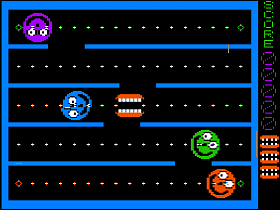 The Game: Ever had a sweet tooth? Now you are the sweet tooth – or teeth, as the case may be. You guide a set of clattering teeth around a mazelike screen of horizontal rows; an opening in each row travels down the wall separating it from the next row. Your job is to eat the tasty treats lining each row until you’ve cleared the screen. Naturally, it’s not just going to be that easy. There are nasty hard candies out to stop you, and they’ll silence those teeth of yours if they catch you – and that just bites. Periodically, a treat appears in the middle of the screen allowing you to turn the tables on them for a brief interval. Sierra On-Line, 1982
The Game: Ever had a sweet tooth? Now you are the sweet tooth – or teeth, as the case may be. You guide a set of clattering teeth around a mazelike screen of horizontal rows; an opening in each row travels down the wall separating it from the next row. Your job is to eat the tasty treats lining each row until you’ve cleared the screen. Naturally, it’s not just going to be that easy. There are nasty hard candies out to stop you, and they’ll silence those teeth of yours if they catch you – and that just bites. Periodically, a treat appears in the middle of the screen allowing you to turn the tables on them for a brief interval. Sierra On-Line, 1982 The Game: You control a round creature consisting of a mouth and little else. When the game begins, you’re given about two seconds’ head start to venture into the maze before blobby monsters are released from their cages and begin pursuing you. As you move, Munch Man leaves a trail in his wake; you advance to the next level of the game by “painting” the entire maze with that trail. (Texas Instruments, 1982)
The Game: You control a round creature consisting of a mouth and little else. When the game begins, you’re given about two seconds’ head start to venture into the maze before blobby monsters are released from their cages and begin pursuing you. As you move, Munch Man leaves a trail in his wake; you advance to the next level of the game by “painting” the entire maze with that trail. (Texas Instruments, 1982)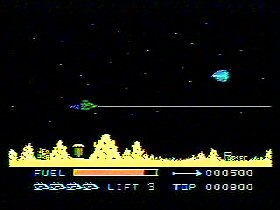 The Game: You control a space patrol fighter cruising over the surface of a planet. Alien attackers swarm on the right side of the screen and strafe you, and you must get out of the way of their laser fire and return some of your own; the more enemy ships you allow to safely leave the screen, the more you’ll have to deal with when they re-enter from the right side of the screen. Avoid their fire, avoid colliding with them, and avoid slamming into the ground, and you might just live long enough to repel the invasion. (Texas Instruments, 1982)
The Game: You control a space patrol fighter cruising over the surface of a planet. Alien attackers swarm on the right side of the screen and strafe you, and you must get out of the way of their laser fire and return some of your own; the more enemy ships you allow to safely leave the screen, the more you’ll have to deal with when they re-enter from the right side of the screen. Avoid their fire, avoid colliding with them, and avoid slamming into the ground, and you might just live long enough to repel the invasion. (Texas Instruments, 1982)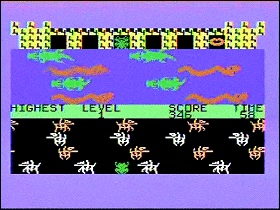 The Game: You’re a frog who has a hot date with the princess in the castle. But in order to reach her, you’ll have to cross four lanes of jousting knight traffic – avoiding the knights’ horses and lances – and then you’ll have to cross the moat on the backs of snakes and alligators, all without ending up in the drink when they submerge. (There’s also occasionally a lady frog you can hook up with en route to the castle; apparently this whole thing with the princess doesn’t have any guarantee of exclusivity.) When you reach the castle, you can hop into any open window, but if you see a pair of lips in that window, that’s where the princess is. (Romox, 1982)
The Game: You’re a frog who has a hot date with the princess in the castle. But in order to reach her, you’ll have to cross four lanes of jousting knight traffic – avoiding the knights’ horses and lances – and then you’ll have to cross the moat on the backs of snakes and alligators, all without ending up in the drink when they submerge. (There’s also occasionally a lady frog you can hook up with en route to the castle; apparently this whole thing with the princess doesn’t have any guarantee of exclusivity.) When you reach the castle, you can hop into any open window, but if you see a pair of lips in that window, that’s where the princess is. (Romox, 1982) The Game: Hellish flying demons try to formation-dive your well-armed, devil-fryin’ vehicle at the bottom of the screen. Each time you knock one of this gargoylesque beasties out of the sky, they drop a piece of a bridge you must drag over to the appropriate spot on the screen. When you’re close to completing the bridge, the Prince of Darkness sends in some heavier artillery – a spooky floating demon head who spits fire at your cannon – to do away with you. Once you’ve toasted the flying meanies out of the sky and cross the bridge, it’s time to do battle with Satan himself. (CBS Video Games, 1982)
The Game: Hellish flying demons try to formation-dive your well-armed, devil-fryin’ vehicle at the bottom of the screen. Each time you knock one of this gargoylesque beasties out of the sky, they drop a piece of a bridge you must drag over to the appropriate spot on the screen. When you’re close to completing the bridge, the Prince of Darkness sends in some heavier artillery – a spooky floating demon head who spits fire at your cannon – to do away with you. Once you’ve toasted the flying meanies out of the sky and cross the bridge, it’s time to do battle with Satan himself. (CBS Video Games, 1982)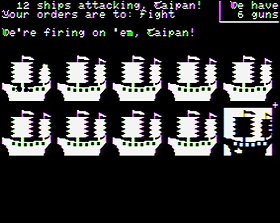 The Game: The coast of 19th century China could be a dangerous place – pirates lay in wait for passing (and relatively defenseless) ships, and that’s just the obvious danger. The buyer’s and seller’s markets in dry goods, weapons, silk and opium could pose just as much of a hazard to an independent trader’s finances. And then there’s Li Yuen’s protection racket… (Avalanche Productions [designed by Art Canfil], 1982)
The Game: The coast of 19th century China could be a dangerous place – pirates lay in wait for passing (and relatively defenseless) ships, and that’s just the obvious danger. The buyer’s and seller’s markets in dry goods, weapons, silk and opium could pose just as much of a hazard to an independent trader’s finances. And then there’s Li Yuen’s protection racket… (Avalanche Productions [designed by Art Canfil], 1982)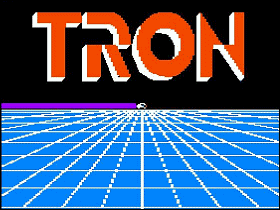 The Game: Up to two players control light cycles that leave a solid light trail in their wake. The object of the game is to trap the other player by surrounding them with a light trail that they can’t avoid crashing into – or forcing them to run into their own trail. Coming into contact with a light trail, either yours or the other player’s, collapses your own trail and ends your turn. The player still standing at the end of the round wins. (“Ivan”, circa 1982)
The Game: Up to two players control light cycles that leave a solid light trail in their wake. The object of the game is to trap the other player by surrounding them with a light trail that they can’t avoid crashing into – or forcing them to run into their own trail. Coming into contact with a light trail, either yours or the other player’s, collapses your own trail and ends your turn. The player still standing at the end of the round wins. (“Ivan”, circa 1982)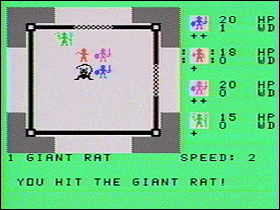 The Game: A party of up to four adventurers descends into the depths of a dungeon to recover their kidnapped king and find his magical orb. Along the way, the band of intrepid adventurers will have to fight off everything from packs of wild dogs to evil creatures determined to bring the quest to an early end. (Texas Instruments, 1982)
The Game: A party of up to four adventurers descends into the depths of a dungeon to recover their kidnapped king and find his magical orb. Along the way, the band of intrepid adventurers will have to fight off everything from packs of wild dogs to evil creatures determined to bring the quest to an early end. (Texas Instruments, 1982)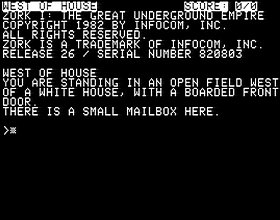 The Game: You are standing in an open field west of a white house, with a boarded front door. There is a mailbox here. (Infocom, 1982)
The Game: You are standing in an open field west of a white house, with a boarded front door. There is a mailbox here. (Infocom, 1982)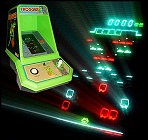 The Game: You are a frog. Your task is simple: hop across a busy highway, dodging cars and trucks, until you get the to the edge of a river, where you must keep yourself from drowning by crossing safely to your grotto at the top of the screen by leaping across the backs of turtles and logs. But watch out for snakes and alligators! (Coleco, 1982)
The Game: You are a frog. Your task is simple: hop across a busy highway, dodging cars and trucks, until you get the to the edge of a river, where you must keep yourself from drowning by crossing safely to your grotto at the top of the screen by leaping across the backs of turtles and logs. But watch out for snakes and alligators! (Coleco, 1982) According to the Guinness Book of World Records, the Commodore 64 still stands today as the best selling computer of all time. Its revolutionary graphic and sound chips combined with an insanely affordable price propelled the Commodore line of computers into the history books. Its 15,000+ game library didn’t hurt, either.
According to the Guinness Book of World Records, the Commodore 64 still stands today as the best selling computer of all time. Its revolutionary graphic and sound chips combined with an insanely affordable price propelled the Commodore line of computers into the history books. Its 15,000+ game library didn’t hurt, either.

 The Game: Players control a caterpillar, hungrily navigating a twisty maze of twigs and branches to eat leaves. Sometimes the player’s caterpillar will have reached a dead end, but this is not revealed until the leaf covering that dead end is consumed. Other insects swarm around the caterpillar, trying to catch and eat it for themselves. At the beginning of each “life” the player can press a button, giving the caterpillar a brief bug-zerker rage, allowing it to eat its enemies for a change, but this change is short-lived; special flowers must be consumed to regain the ability. Once all of the leaves have been eaten in an entire maze (which takes up more than a single interlinked screen), a “home” appears, into which the caterpillar must be successfully guided for transformation into a butterfly. Then the player is given a new caterpillar to guide and a new maze to navigate. (Valadon Automation [under license to Iti S.A.], 1983)
The Game: Players control a caterpillar, hungrily navigating a twisty maze of twigs and branches to eat leaves. Sometimes the player’s caterpillar will have reached a dead end, but this is not revealed until the leaf covering that dead end is consumed. Other insects swarm around the caterpillar, trying to catch and eat it for themselves. At the beginning of each “life” the player can press a button, giving the caterpillar a brief bug-zerker rage, allowing it to eat its enemies for a change, but this change is short-lived; special flowers must be consumed to regain the ability. Once all of the leaves have been eaten in an entire maze (which takes up more than a single interlinked screen), a “home” appears, into which the caterpillar must be successfully guided for transformation into a butterfly. Then the player is given a new caterpillar to guide and a new maze to navigate. (Valadon Automation [under license to Iti S.A.], 1983)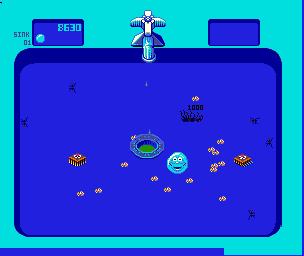
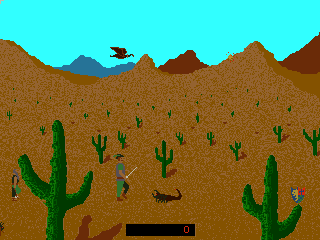 The Game: Your friends (wait a minute, I’ve never seen these people before in my life!) are venturing through treacherous deserts, unfriendly villages, and a variety of other inhospitable settings. Armed with a crossbow – controlled with a fancy light gun mounted on the arcade cabinet – your job is to pick off any threats, be they nasty critters, falling projectiles, snipers, or what have you, and allow your friends to pass safely. (Exidy, 1983)
The Game: Your friends (wait a minute, I’ve never seen these people before in my life!) are venturing through treacherous deserts, unfriendly villages, and a variety of other inhospitable settings. Armed with a crossbow – controlled with a fancy light gun mounted on the arcade cabinet – your job is to pick off any threats, be they nasty critters, falling projectiles, snipers, or what have you, and allow your friends to pass safely. (Exidy, 1983)